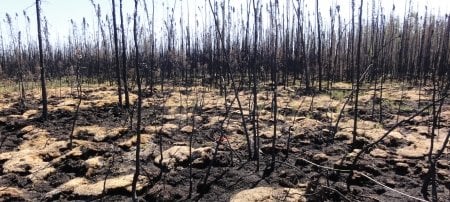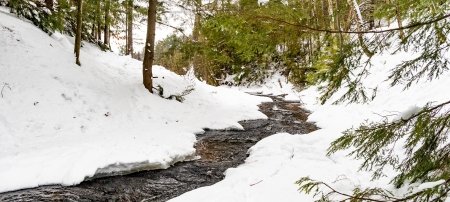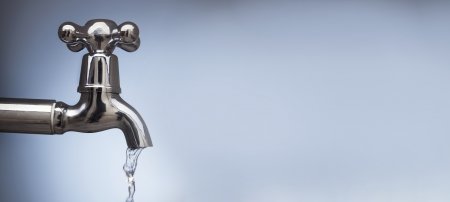A centuries-old kernel of corn’s journey lets us explore the Carbon, Water and Soils Lab, where samples are graphitized for radiocarbon dating.
What secrets can a tiny corn kernel hold? How did a shell, likely from the Gulf of Mexico, end up in a 400-year-old refuse pit in Illinois? These are questions radiocarbon dating can solve.
In the early 17th century, before European explorers made contact with the Oneota Nation, members of the tribe inhabited a village in what is now Midewin National Tallgrass Prairie in Wilmington, Illinois. Skip forward to present day. Archaeologists from Notre Dame University excavating the site unearthed the kernels of corn and shells, which they sent to the Carbon, Water and Soils Lab for radiocarbon dating, hoping to learn more about mobility, trade and land use of the people who occupied the land.
The Carbon, Water and Soils Lab is housed in the USDA Forest Service’s (USFS) Northern Research Station in Houghton, Michigan and is the graphitization lab for the Radiocarbon Collaborative, a partnership between Michigan Technological University, USFS and the W.M. Keck Carbon Cycle Accelerator Mass Spectrometer Facility at University of California, Irvine.

The Collaborative is much more than a lab running samples, however.
“We’re an outreach organization. We’re also responsible for educating people about the proper application of radiocarbon because it’s often misinterpreted or misapplied,” said Kate Heckman, USFS research biological scientist and primary administrator of the Radiocarbon Collaborative.
The Collaborative’s goal is improving researchers’ access to radiocarbon analysis, and assisting those researchers with interpretation and publication of results.
How does radiocarbon dating work?
Radiocarbon is a radioactive isotope of carbon (14C), which is constantly created by the interaction of cosmic rays with atmospheric nitrogen. The radiocarbon combines with atmospheric oxygen to create radioactive carbon dioxide, consumed by plants during photosynthesis.
Scientists can measure the amount of radiocarbon in an organic sample to determine the age of the sample and infer when the plant (or animal that ate it) died. The older the sample, the less radiocarbon is detected, because radiocarbon decays over time. Radiocarbon dating can be used for samples up to about 50,000 years old. Beyond that, there is not enough detectable radiocarbon.

“Radiocarbon abundance of a sample will tell you a sample’s age — this is helpful if you happen to be an archaeologist interested in dating how old what you’ve unearthed at a dig is,” Heckman said. “In earth systems science, radiocarbon dating is used to track how carbon cycles through the biosphere, such as carbon turnover in soils and its transport into lakes and oceans from streams.”
However, radiocarbon is not evenly distributed around the globe. Urban centers, with their increasing amounts of carbon dioxide pollution, are considered “radiocarbon dead” because the increased carbon creates a reservoir effect in organic tissues. The reservoir effect influences the radiocarbon signature, which means researchers could be hundreds or thousands of years off in their estimations.
“You don’t just stick the sample in the machine and it tells you when the Los Angeles basin was first occupied,” Heckman said. “Samples must be analyzed within the context of how the sample was created and where it came from.”
The Radiocarbon Collaborative’s goal is to help people understand the science behind radiocarbon dating to help people do better science by avoiding inaccurate dating. And because a picture (or in this case, video) is worth a thousand words, in the Live Lab Tour video, lab technicians walk viewers through the process of graphitization.

Carbon, Water and Soils Lab Tour
The graphitization process
But before a sample can be dated, it must be graphitized, which turns the organic material into solid carbon, through a process that involves a spectacular show of fire and ice.
Paula Zermeño, the Carbon, Water and Soils Lab manager, estimates she has prepped more than 100,000 samples during her career.
“I think I’ve graphitized a sample of just about everything that contains carbon, including everything from eyeball lenses and Viking toes to atmospheric carbon dioxide and soil organic matter,” Zermeño said.
The process to purify the samples by stripping away any modern carbon is straightforward: First Zermeño performs acid and base washes of the sample — in this case, corn kernels — before weighing the sample into a glass vial and adding copper oxide as an oxygen source. She takes the vial to the torching station, where she places it onto a vacuum line to remove any atmospheric carbon dioxide from the sample vial. Then she seals off the vial with a hydrogen-oxygen torch; the bright-white light of the extremely hot torch requires special safety goggles to avoid human eye damage.
Once a sample is isolated, Zermeño slips the glass vial into a ceramic tube, which she places in a combustion furnace. She bakes the sample at 900 degrees Celsius for about four hours, during which time the sample combusts to carbon dioxide.
Then Zermeño puts the glass vial onto a vacuum line where it is cracked open to release the carbon dioxide to the vacuum line. The vacuum line is fitted with various cold traps, used to further purify the carbon dioxide and move it down the vacuum line. First, a mixture of isopropanol and dry ice is used to freeze out water vapor that formed during sample combustion, separating water from carbon dioxide.
Using liquid nitrogen — which, when spilled, skitters across the table like a hundred sparks — Zermeño can freeze down the carbon dioxide to measure its mass (approximately 1 mg) and capture it in a “reactor” which contains an iron catalyst. Hydrogen gas is then added to the reactor. When heat is applied to the reactor, carbon dioxide is converted to solid graphite, which precipitates on the surface of the iron catalyst. The graphite and iron mixture is then pressed into the hole of an AMS (accelerator mass spectrometer) target. The sample is then shipped off for AMS analysis.
And that's how a kernel of corn that lay inside a refuse pit for hundreds of years is converted to pure carbon in the form of graphite. And by analyzing that graphite, an archaeologist sees into the past.
Michigan Technological University is an R1 public research university founded in 1885 in Houghton, and is home to nearly 7,500 students from more than 60 countries around the world. Consistently ranked among the best universities in the country for return on investment, Michigan's flagship technological university offers more than 185 undergraduate and graduate degree programs in science and technology, engineering, computing, forestry, business, health professions, humanities, mathematics, social sciences, and the arts. The rural campus is situated just miles from Lake Superior in Michigan's Upper Peninsula, offering year-round opportunities for outdoor adventure.






Comments